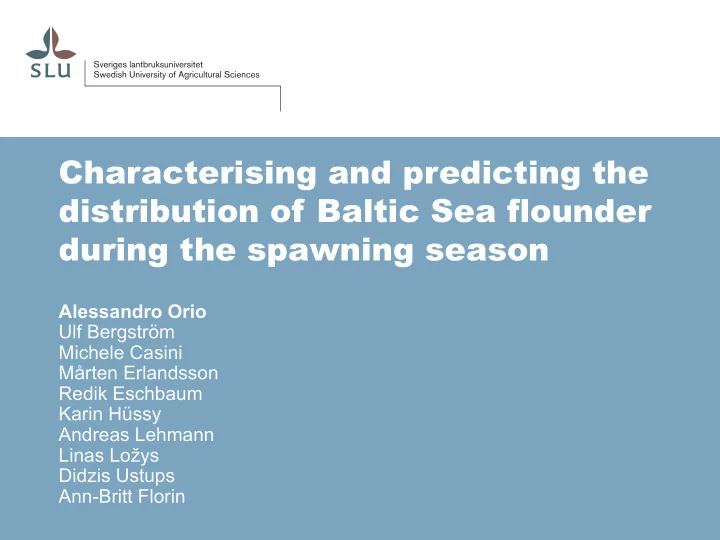

Characterising and predicting the distribution of Baltic Sea flounder during the spawning season Alessandro Orio Ulf Bergström Michele Casini Mårten Erlandsson Redik Eschbaum Karin Hüssy Andreas Lehmann Linas Ložys Didzis Ustups Ann-Britt Florin
Flounder ( Platichthys flesus ) • Two sympatric flounder ecotypes are present in the Baltic Sea, pelagic and demersal spawning flounder. • The pelagic spawning flounder spawns in deep waters. • The demersal spawning flounder spawns directly on the bottom in shallow coastal areas and on offshore banks. • The demersal spawning ecotype is occurring in the northern, less saline areas of the Baltic Sea. However, in the central areas of the Baltic Sea the spatial distribution of the two ecotypes is overlapping.
Research questions 1. What environmental conditions characterize the spatial distribution and abundance of adult flounder during the spawning season? 2. What are the main factors defining the habitats of the two flounder ecotypes during the spawning season? 3. Where are the potential spawning areas of flounder?
Overview of the data • INSPIRE gillnet data • 2014-2015 • Spring (March-May) • Habitat variables from video • Environmental data from CTD • Extra GIS layers on other variables
Gillnet variables • Water depth • Secchi depth • Abundance of round goby (Neogobius melanostomus) • Abundance of cod ( Gadus morhua ) Environmental variables • Salinity at the bottom • Temperature at the bottom • Oxygen at the bottom
Extra GIS layers • Bottom current • Index of wave exposure Habitat variables • Proportion of soft bottom coverage • Proportion of habitat forming vegetation coverage • Proportion of filamentous and drifting algae coverage • Proportion of mytilus coverage
Modelling • GAMs for flounder ≥ 20 cm (negative binomial distributions) 1. All depths of the spring survey data and without habitat variables. Will be use for spatial predictions → general model
Modelling 2. Only shallow waters < 30 m including habitat variables to take in consideration demersal spawners → demersal model 3. Only deep waters ≥ 30 m excluding habitat variables to take in consideration pelagic spawners → pelagic model
1. General model
2. Demersal model
3. Pelagic model
Spatial predictions • Results from the general model . • 3 periods based on oxygen condition: 1993-1997, 2003- 2007 and 2014. • To avoid unrealistic extrapolation we restricted the depth range (depth > 80 m = 80 m). • We also applied physiological limits: • oxygen < 1 ml/l • depth ≥ 30 m and salinity < 10 PSU • depth < 30 m and salinity < 6 PSU
Spatial predictions
Spatial predictions Habitat availability SD Period Pelagic Demersal 1993-1997 57.5 100 24-25 2014 60.7 100 1993-1997 36.1 100 26&28 2014 28.5 100 High quality habitat SD Period Pelagic Demersal 1993-1997 22.1 19.6 24-25 2014 28.5 35.5 1993-1997 1.9 5.3 26&28 2014 0.2 8.9
Conclusions • The distribution of spawning flounder is controlled by different factors. • The loss of flounder's spawning areas could have serious implications on the future dynamics of the different stocks of flounder. • Knowledge of spawning areas and other essential fish habitats is a prerequisite for the integration of fisheries into marine spatial planning.
Thank you for your attention! Any questions? This project has received funding from BONUS (Art 185) funded jointly from the European Union’s Seventh Programme for research, technological development and demonstration, and from the Baltic Sea national funding institutions.
Summary General model: • Dual depth distribution and salinity preference. • High Secchi depth preference. Demersal model: • Vegetation and substrate did not play an important role in habitat choice. • Negative interaction with round goby. Pelagic model: • Negative relation with temperature and bottom current and positive with salinity. Spatial predictions: • Spawning habitat availability have decreased.
Recommend
More recommend